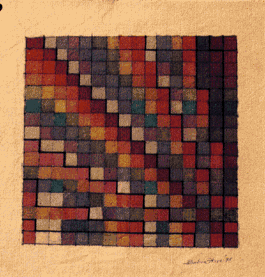
SIXTY FOUR SQUARES OF THE LAMBDOMA DIAGRAM COLORED ACCORDING TO COLOR TONE THEORIES
The upper horizontal set of colored squares depicts the
overtone series in music. When a string is struck other harmonies occur at the
same time. The order of these harmonics are in great leaps at the beginning, an
octave first and then a fifth, another octave and then a third, then a minor
sixth, and finally a scale of whole tones to half tones.
The verticals
always follow the theoretical undertones series. which instead of being octave
to fifth, becomes octave to fourth, octave, sixth, fourth, second, then a
descending whole tone to half tone scale, as contrasted with the ascending
overtone scale.
The overtone scale also would diminish in a special sense,
while the undertone would lengthen in a special sense. The diagonal colors all
represent the same tone the same octave range, a constant, and also a hypotenuse
of a right triangle. The upper half of the square cut by its diagonal would be
in the upper octaves, while the lower half would be in the lower octaves. Also
the upper half would represent a contraction while the lower half would
represent an expansion.
As a tone is struck, each tone beginning from its
point on the diagonal shifts a space back on the horizontal, and shifts a space
on the vertical. This already creates paradoxical situation. Rays are visibly
emanating from the source of the sound. On one side, the overtone side, the
colors go from red to orange to yellow to green to blue to purple to red. On the
other side, the undertone part, the colors go from lavender to blue to green to
yellow to orange to red when they again begin to fluctuate widely into
complementaries or fifths musically.